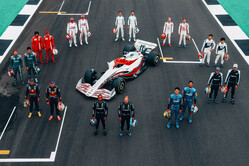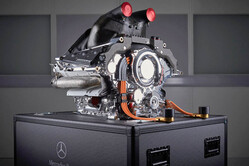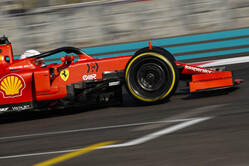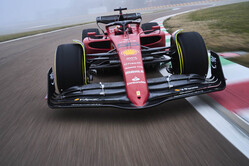 Formula 1 will introduce a new set of technical regulations for the upcoming season, with new models set to be essentially different in philosophy to what has been raced in previous seasons.
Formula 1 will introduce a new set of technical regulations for the upcoming season, with new models set to be essentially different in philosophy to what has been raced in previous seasons.
The purpose of the new regulations is, basically, to enable drivers to follow each other far more closely while also reducing overall costs by streamlining the overall design.
With years of research in the back, the aim is to make racing more equitable and sustainable while improving racing performance.
Here's all you need to know about the new models which will hit the tracks for the first time in 2022.
Why is F1 changing?
F1 supporters are probably wondering why - after one of the most successful seasons in decades - F1 is completely overhauling its cars and rules.
There are a few reasons for that. Normally, regulations have been completely revamped for safety, as if F1 just keeps allowing teams undergoing technical changes to make their cars faster - the last era of Formula 1 cars were the quickest we know - then it gets more difficult to make racing as safe as possible.
Safety may have been a factor for the 2022 revolution, although the main reason is that F1 wanted to move from a Mercedes-dominated era while also providing several opportunities than hoped because of the speed, weight, and downforce of the vehicles.
The new set of regulations and technical improvements were initially scheduled for 2021 before being delayed by a global pandemic, are targeted at improving the show, first and foremost, and F1 is expecting plenty of excitement.
What are the new changes?
1. Frozen power units
 Recent hybrid power units have now been part of F1 for eight years, and in that time, some remarkable development has taken place. But with the latest power unit regulations being completed by the various manufacturers - for a 2026 hybrid engine that will be sustainably fuelled - F1 leaders have agreed to freeze power units from 2022 onwards as focus moves to the future.
Recent hybrid power units have now been part of F1 for eight years, and in that time, some remarkable development has taken place. But with the latest power unit regulations being completed by the various manufacturers - for a 2026 hybrid engine that will be sustainably fuelled - F1 leaders have agreed to freeze power units from 2022 onwards as focus moves to the future.
These restrictions are set to reduce the necessary resources to chase what are increasingly small gains, keeping costs to a minimum for customers at the same time as allowing work on the next generation of power units to start in force.
However, that doesn't mean that any reliability problems that may take place will be reserved for the next four seasons because manufacturers are allowed to apply to the FIA to undergo modifications "for the purpose of safety, reliability, cost-saving, or minimum incidental changes", while a number of smaller gears are also omitted from the homologation restrictions.
2. The switch to 18-inch wheels
 It's a change that's been expected for a while now and also a shift away from the traditional 13-inch wheel, which has been around for more than 30 years. 2022 sees new models racing with 18-wheels for two reasons: improved aesthetics of larger wheels and greater relevance towards road car technology.
It's a change that's been expected for a while now and also a shift away from the traditional 13-inch wheel, which has been around for more than 30 years. 2022 sees new models racing with 18-wheels for two reasons: improved aesthetics of larger wheels and greater relevance towards road car technology.
For instance, the new 18-inch tyres from Pirelli, which were continuously tested by the F1 teams, run on the same pace width but with a larger diameter. The biggest change will be the sidewall reduction, which currently resembles a road car. We're expecting the cars to be handled differently due to the changed behaviour of the tyres, making them more precise due to the far-flung stiffer sidewall.
The new 18-inch wheels resulted in positive driver feedback, with less impact on the car aerodynamics and tyre flex. This improved stability translates into less maintenance that involves addressing the turbulence, resulting in lower costs.
According to AccidentClaims.co.uk, the FIA switch from 13-inch to 18-inch tyres is estimated to greatly impact overall driver safety.
On the other hand, Wheel covers return for the first time since 2009 to minimise the aerodynamic wake induced by cars for the safety and benefit of those behind. The only downside is the reduced downforce of the vehicle itself.
Over-wheel winglets are also ready to be integrated into the new models, something that has never been done in F1 before. Their purpose is to direct the mass of air coming off the front wheels and deter it from the rear wing.
3. A complete change of aerodynamics
 The 2022 new F1 transformations will see cars using an entirely different form of aerodynamics. Ground effect, which was massively appreciated in the 80s, created suction underneath the vehicle to pull it, not the runway.
The 2022 new F1 transformations will see cars using an entirely different form of aerodynamics. Ground effect, which was massively appreciated in the 80s, created suction underneath the vehicle to pull it, not the runway.
F1 rejected the ground effect idea almost 40 years ago, with the focus shifting more towards over-car airflow. But the unexpected result was F1 cars being unable to follow each other's close, which pushed Formula 1to return to the traditional ground-effect formula.
The new models will feature underflow tunnels that will create large amounts of ground effect downforce. Without the necessity for disruptive aerodynamic appendages like flaps, lips, vortex-generating barge boards and scoops, following vehicles should be less troubled by those in front of them.
Besides that, the front wing revamp for 2022 is also much simpler. Although the new front will clearly generate downforce in the traditional way, it's heavily focusing on controlling the front-wheel wake and down the vehicle in a much less disruptive way.
The purpose is to send the mass of air to the sides of the vehicle in a fluid manner rather than push out or underneath the sides.
The new rear wing doesn't only look great, but the design is also meant to amass wake from the back wheels and redirect it into the flow coming from underneath the vehicle.
























